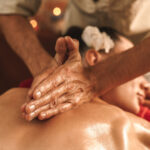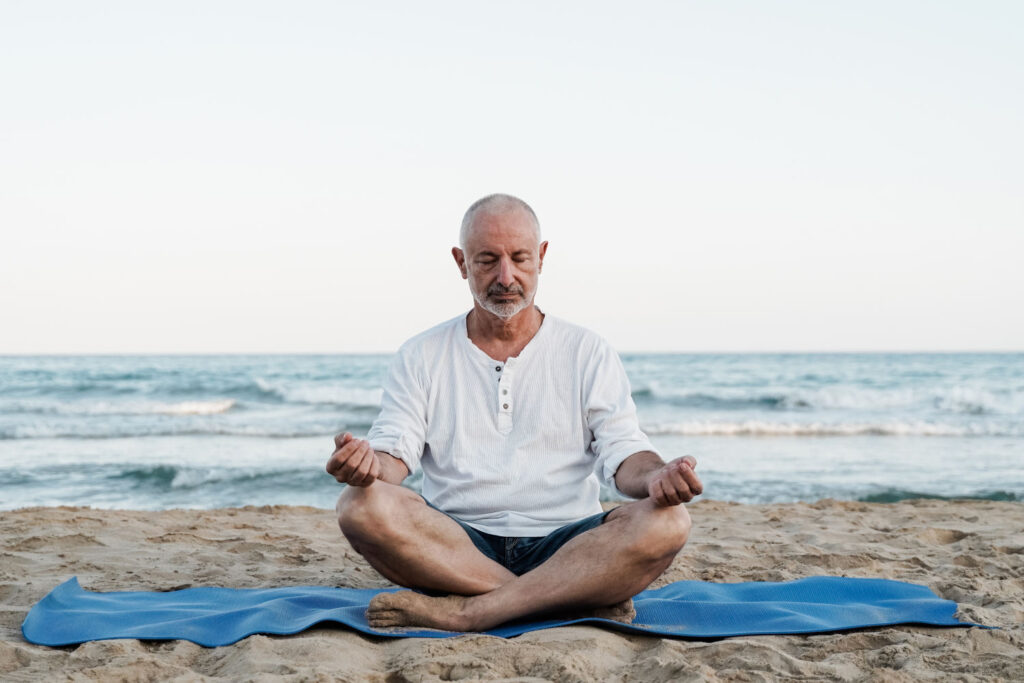Thoughts are racing, deadlines are pressing – and in the midst of it all, the desire for a moment to pause. Meditation gives us precisely this space. Not as a complicated technique, but as an invitation to return to the now. Studies prove its power, but its value can only be experienced. Perhaps this is where your journey to inner clarity begins.
The most important facts in brief:
- Easy to get started: Meditation requires no special prior knowledge or equipment – 5 minutes of daily practice is enough to get you started.
- Scientifically proven: Regular meditation has been shown to change brain structures and lower stress hormones such as cortisol.
- A variety of techniques: From breath observation and body scans to walking meditation, there is a suitable method for every type.
- Continuity instead of perfection: Regular short exercises are more effective than occasional long sessions.
- Holistic effect: Meditation not only improves mental clarity, but also physical health and interpersonal relationships.
Contents
- What is meditation?
- Regular meditation strengthens the mind
- Various meditation techniques for beginners
- Meditation practice for advanced learners
- Common mistakes and how to avoid them
- Meditation at the Ayurveda Resort Mandira
- Frequently asked questions
What is meditation?
Meditation refers to a group of mental exercises aimed at consciously directing attention. The term comes from the Latin “meditatio” (reflection, contemplation) and describes practices that can be found in almost all world religions and spiritual traditions. At its core, it is about calming the mind and reaching a deeper level of consciousness.
The definition of meditation includes various techniques for training mindfulness and concentration. Modern forms of meditation have often been detached from their traditional spiritual contexts and adapted as secular techniques. They focus on the conscious perception of the present moment without judging it.
Did you already know?
Mindfulness meditation is now used in many clinics to treat mental health problems and has been well researched scientifically. The MBSR (Mindfulness-Based Stress Reduction) program is considered one of the best-studied meditation methods.
Regular meditation strengthens the mind
Regular meditation leads to measurable changes in the brain and throughout the body. Scientific studies have shown numerous positive effects on mental and physical health. Research results show that certain areas of the brain can be changed through regular meditation.
Meditation has been proven to reduce stress hormones such as cortisol and noradrenaline in the body. This leads to an improvement in mood and a more balanced emotional state. Regular meditation can also significantly improve the quality of sleep and increase the ability to concentrate.
Various meditation techniques for beginners
For beginners, there are simple and accessible meditation techniques that can be practiced without prior knowledge. Regular practice is more important than the duration of the individual sessions. These basic exercises form the foundation for a long-term meditation practice.
Mindfulness exercise with breathing focus
Breathing meditation is one of the most basic and effective techniques for beginners. Sit comfortably, close your eyes and focus your attention on the natural flow of your breath. Observe how the air flows in and out through your nose without controlling your breath.
When thoughts arise, notice them without judging them and gently direct your attention back to your breath. This simple exercise trains your ability to concentrate and promotes inner peace. Start with 5 minutes a day and gradually increase the duration.
Guided meditation
Guided meditations are ideal for beginners as they provide clear instructions and make it easier to concentrate. Apps, podcasts or online platforms offer numerous free instructions in various lengths and for different goals such as relaxation, stress reduction or better sleep.
Start by choosing short sessions of 5 to 10 minutes and simply follow the instructor’s voice. The guidance of experienced meditation teachers helps to focus the mind and avoids typical beginner’s mistakes. As you gain experience, you can move on to longer meditation sessions.
Relaxing body scan variation
The body scan is an effective technique for developing body awareness and releasing tension. Lie comfortably on your back and systematically direct your attention through your body, starting with your toes and working up to your head.
Feel into every part of your body, perceive sensations and release tension with every exhalation. This method promotes body awareness and helps to recognize subtle stress signals at an early stage. The body scan can be used both as a stand-alone practice and as preparation for other meditation techniques.
Meditation practice for advanced learners
With increasing experience, you can deepen and expand your meditation practice. Advanced techniques require more concentration and inner stability, but also offer deeper insights and more intense experiences. The regularity of the practice is more important than the complexity of the technique.
Walking meditation for intense mindfulness
Walking meditation (also known as Kinhin) integrates mindfulness into movement and is particularly suitable for people who have difficulty with longer sitting meditations. Walk slowly and consciously while focusing your attention on the sensations in your feet and legs.
Feel the rolling of the feet, the shifting of the weight and the movement of the muscles. This practice trains the ability to stay present in everyday life and can serve as a bridge between formal meditation and daily activities. You can start with 10-15 minutes and adjust the duration as needed.
Build up longer sitting practice
As you gain experience, you can gradually extend your sitting meditations. Start with 20 minutes and gradually increase the duration to 30, 45 or 60 minutes. A stable sitting posture with an upright back supports longer meditation phases.
Experiment with different meditation objects such as the breath, body sensations, sounds or a mantra. Longer sessions allow for deeper states of concentration and insight. It is important not to cling to results, but to appreciate and enjoy the process itself.

Common mistakes and how to avoid them
Beginners and advanced practitioners encounter various challenges on the path of meditation. Recognizing and overcoming these typical obstacles is an important part of the practice itself. Patience and self-love are just as important as the right technique.
Expectations too high
Many beginners expect immediate results or special experiences through meditation. This often leads to disappointment and premature giving up. Understand meditation as a long-term process whose effects unfold subtly and gradually.
Observe your expectations with the same mindfulness with which you observe your breath. True success in meditation does not lie in extraordinary experiences, but in the growing ability to meet the present moment with openness and acceptance.
Incorrect sitting posture
An uncomfortable or unstable sitting posture can lead to pain and make meditation considerably more difficult. Experiment with different positions – on a chair, cushion or meditation stool – to find the posture that suits you best.
The back should be upright but not tense, the shoulders relaxed and the neck straight. A stable posture supports mental stability and enables longer periods of meditation without unnecessary distractions caused by physical discomfort.
Unstable routine
One of the biggest challenges is establishing a regular meditation practice. Irregular practice leads to less noticeable results and makes progress more difficult. Integrate meditation into your daily routine, ideally at the same time and in the same place.
Start with a realistic time frame – five minutes a day is better than an hour once a week. Continuity is more important than the duration of the individual sessions. A helpful strategy can be to combine meditation with already established habits, such as having coffee in the morning or brushing your teeth in the evening.
Relieve headaches
Meditation can also help with physical ailments. In our article, you’ll learn how to relieve headaches using targeted meditation techniques—a natural complement to conventional treatment methods.
Relieve headaches through meditation >
Meditation at the Ayurveda Resort Mandira
Whether for stress relief, to improve concentration, or as a daily ritual for greater mindfulness – meditation unfolds its effects wherever we allow it. It doesn’t require perfection, but rather presence. Those who practice regularly not only give themselves inner balance, but also a deeper sense of what is essential. Perhaps it’s time to view meditation not just as a technique, but as a companion.
Find peace now
Experience how meditation and Ayurveda lead to new clarity and deep relaxation in our treatments. A place to recharge – for body, mind, and soul.
Frequently asked questions
Can you meditate while lying down?
Yes, you can also meditate lying down, for example during body scan exercises or to help you fall asleep. It is important to adopt an alert posture: your arms are at your sides and your back is straight. Sitting is recommended if you are at risk of falling asleep. For guided meditation or mindfulness exercises, lying down is a common alternative to sitting.
How do you know if you are meditating properly?
You can tell that you are meditating properly by remaining present in the moment and letting thoughts come and go without following them. It’s not about emptiness in your head, but about mindful awareness. Restlessness or distraction are also part of it – the decisive factor is returning to attention.
Can you do anything wrong when meditating?
You can go wrong when meditating if you have too high expectations or put yourself under pressure. Meditation is not an achievement, but a practice in mindfulness. Uncomfortable sitting postures, a lack of regularity or holding on to certain results can be a hindrance – mistakes from which you learn.
Should you think about things while meditating?
When meditating, you should not consciously think about things, but observe thoughts without getting lost in them. The aim is to return to the chosen focus of attention – usually the breath. Brooding or thinking is not part of meditation practice, but is considered a distraction.
When is the best time to meditate?
The best time to meditate is in the morning after getting up, when the mind is still clear and the day has a structured start. The evening before going to bed is also a good time. A fixed time in the daily routine is crucial in order to establish a sustainable meditation routine.
Cover image: © Vane Nunes – stock.adobe.com; Image 1: © sebra – stock.adobe.com


